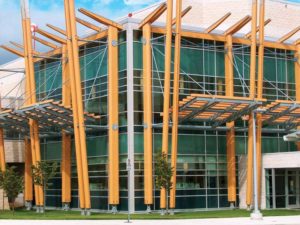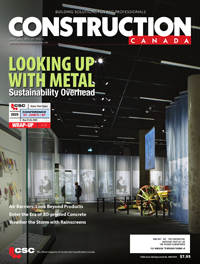Essential knowledge for consistent fenestration specification
| Sidebar 1 – Standards, protocols, guides, and test methods noted in this article |
| Standards, protocols, guides, and tests methods noted in this article • AAMA/WDMA/CSA 101/1.S.2/A440-17 North American Fenestration Standard (NAFS), Specification for windows, doors, and skylights. • CSA A440S1-19 Canadian Supplement to AAMA/WDMA/CSA 101/I.S.2/A440-17, NAFS, Specification for windows, doors, and skylights. • AAMA 501-05, Methods of Test for Exterior Walls.* • AAMA 501.1-05, Standard Test Method for Water Penetration of Windows, Curtain Walls and Doors Using Dynamic Pressure.* • AAMA 501.2-09, Quality Assurance and Diagnostic Water Leakage Field Check of Installed Storefronts, Curtain Walls, and Sloped Glazing Systems.* • AAMA 501.4-09, Recommended Static Test Method for Evaluating Curtain Wall and Storefront Systems Subjected to Seismic and Wind-Induced Inter-Story Drifts.* • AAMA 501.5-07, Test Method for Thermal Cycling of Exterior Walls.* • AAMA 501.6-09, Recommended Dynamic Test Method for Determining the Seismic Drift Causing Glass Fallout from a Wall System.* • AAMA 910-10, Voluntary “Life Cycle” Specifications and Test Methods for AW Class Architectural Windows and Doors.* • AAMA 2604-13, Voluntary Specification, Performance Requirements and Test Procedures for High Performance Organic Coatings on Aluminum Extrusions and Panels (with Coil Coating Appendix).* • AAMA 2605-13, Voluntary Specification, Performance Requirements and Test Procedures for Superior Performing Organic Coatings on Aluminum Extrusions and Panels (with Coil Coating Appendix).* • AAMA 611-14, Voluntary Specification for Anodized Architectural Aluminum.* • ASTM E283-04, Standard Test Method for Determining Rate of Air Leakage Through Exterior Windows, Curtain Walls, and Doors Under Specified Pressure Differences Across the Specimen. • ASTM E331-00, Standard Test Method for Determining Rate of Air Leakage Through Exterior Windows, Curtain Walls, and Doors Under Specified Pressure Differences Across the Specimen. • ASTM E547-00, Standard Test Method for Water Penetration of Exterior Windows, Skylights, Doors, and Curtain Walls by Cyclic Static Air Pressure Difference. • ASTM E330/330M-14, Standard Test Method for Structural Performance of Exterior Windows, Doors, Skylights and Curtain Walls by Uniform Static Air Pressure Difference. • ASTM E1748-95, Standard Test Method For Evaluating The Engagement Between Windows And Insect Screens As An Integral System. • CAN/CSA A440-00/A440.1-00, Windows/Special Publication; A440.1-00, User Selection Guide to CSA Standard; CAN/CSA-A440-00, Windows* – Do not use.Notes * Non-mandatory standards |

When it comes to Other Fenestration Assemblies, NBC 2020 Section 5.9.3. provides minimal requirements for air leakage tested at an air pressure difference of 75 Pa (1.57 psf) that is not greater than 0.2L/(s•m²) [0.30 cfm/sf] as per ASTM E283-04 (refer to Sidebar 3, page 4).
Water penetration compliance for NBC 2020 is achieved with either ASTM E331-00 or ASTM E547-00. The penetration resistance of the Other Fenestration Assemblies products must be capable of resisting driving rain pressure as determinate using the protocol and the climate design data defined in CSA A440S1-19.
ASTM E330/330M-14 is the acceptable protocol for structural and environment loads by reference in the NBC 2020 notes. Regarding loads, consult the NBC 2020 “Part 5 – Environmental Separation, Section 5.2 Loads and Procedures,” to review all loads affecting the Other Fenestration Assemblies due to a project’s specific conditions, location, and design. Even if these are not part of mandatory testing protocols, various loads can affect the fenestration components, and may require either project-specific testing or calculations.
Additional testing methods listed in the NBC 2020 notes include AAMA 501-05, AAMA 501.1-05, AAMA 501.4-09, AAMA 501.5-07, and AAMA 501.6-09 (refer to Sidebar 1 on previous page). These are not mandatory but offer helpful guidance for the specifications professional.





